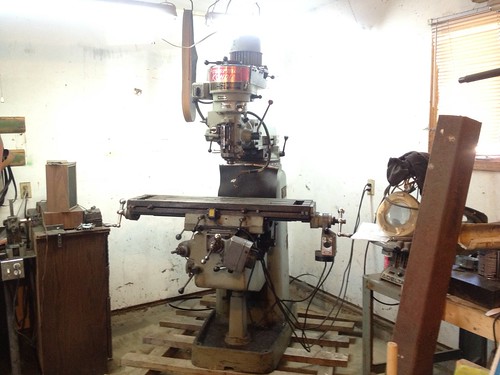The mill is made by Kondia, which is an import brand (Spain) of Clausing. It's a powermill, model G (essentially a bridgeport clone), with a 2hp 3 phase motor and 9x42 table. It came with powerfeeds for the x and y axes, though I may put the y axis motor on the z crank if I can.
The machine itself is about 30 years old or so, but over all it seems to be in pretty solid condition. It has the standard spots of rust all over, but the ways and lead screws look great, and it came with a manual that showed a relatively consistent maintenance log, including a handful of parts that have been replaced over the years. The table does show a few drill/mill marks here and there as well, but overall, nothing I can't work around.
I decided to go with a VFD to power the machine rather than a phase converter, mainley because I found a VFD for about 100 bucks vs. paying 300 to 500 for a rotary phase converter. A static phase converter is just about worthless IMO, as it's really just a glorified motor starter, and doesn't give you true 3 phase operation anyhow. It's an 8 speed belt feed (85 to 3000 rpm) but the VFD will essentially give me an infinite speed option.
I still need to get a good vise and a bunch of tooling for it, but I'm really hoping to start taking on somemore complex projects such as various types of folding knives. I also have the option of milling gaurds, making various jigs and tooling, and really so many other projects where the imagination is almost the limit. Even simple tasks like drilling holes is going to be so much more accurate easier to do. My next big purchase after the vise will be a DRO.
Then I hope to slowly build my tooling and start saving up for a good lathe as well.

 Funny how I always start small/cheap and end up on the other side of the spectrum... hahah
Funny how I always start small/cheap and end up on the other side of the spectrum... hahah


